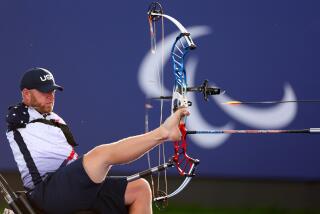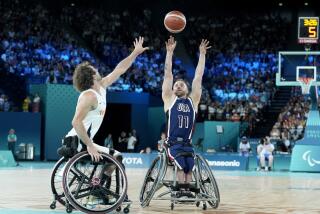Couple Wear Karate’s Black Belt of Courage : Self-Defense Helps Cross Boundaries Built by Disability
- Share via
Bowing heads at the training floor’s edge, 11 students in white uniforms and black belts run into the room’s center and kneel in two straight lines. The meditation begins. Eyes are closed. Breathing is deep. Minds are cleared. The outside world is erased. Bodies are prepared for battle.
That “battle” is karate training, and two “soldiers” in particular have been braving this arena against a seemingly insurmountable enemy. Don and Susan Bleich have cerebral palsy, a condition resulting from brain damage that affects the central nervous system and has hampered their speech and muscle control since birth.
Highest Achievement
Yet, four years after the Bleiches packed their first punches at the West Valley Karate Club in Canoga Park, the couple were awarded black belts, the highest level of achievement in the martial arts. Susan, 43, earned her distinction in March. Don, 48, won his in June.
The Sherman Oaks couple says karate has helped them cross the physical and mental boundaries that can be built by their disability. Working out in the same class with karate champions who look like they could have rivaled the late Bruce Lee in his prime, the Bleiches have marched into new territories of life, stretching previously taut muscles, stabilizing shaky walks and igniting internal energy that radiates the message: “I am not a walking victim.”
A newspaper delivery man for 30 years, Don Bleich thought karate might come in handy for possible hostile physical encounters on his route, but his impetus exploded after he and Susan were assaulted on their way to dinner one night.
Heading toward the car in the driveway at the home of Susan’s mother, Agatha Grundman, the couple noticed two men passing by but thought nothing of it. Grundman sat in the back seat and closed the door. Susan was getting in the passenger seat while Don walked around the back of the car toward the driver’s seat when the men attacked.
“One guy had a gun on Don. He wanted his wallet,” Susan said. “I heard the gun go off, but somehow Don got around to the driver’s seat. He wasn’t hurt. He got in the car and started honking the horn.”
Meanwhile, Susan fought off the second man. She tried to close the door; the assailant opened it. “It was like a seesaw. He hit me on the cheek, but I kept pushing him away,” Susan recalled. Attempting to snatch Grundman’s purse, Susan’s assailant reached inside to unlock Grundman’s door. Though Grundman struck his hand repeatedly, he eventually grabbed the purse under Grundman’s feet. The purse handle broke. “He fell back. We all got in the car and locked our doors,” Susan said.
Don Bleich visited a couple of karate clubs in the San Fernando Valley to inquire about classes but found little encouragement, he said. Then a friend told him about classes for the disabled at the West Valley Karate Club. He and Susan enrolled in the free Saturday morning class, which continues to be offered today for the deaf, blind, developmentally disabled and individuals restricted to wheelchairs.
Hooked on the training, they increased their class load and entered sessions with the able-bodied. Then they advanced through the belt ranks--first a white belt, then green, brown, and finally black.
“Draw feet and arms into the body. Get ready for sidekicking . . . Hands stretch out as though holding a pole . . . Strike with your hands by whipping around and pulling back,” the instructor says. “ Oos !” responds the class with a saying (pronounced gutterly like “us”) that signifies respect and recognition for a command. “Now do the entire kata (a combination of movements) from start to finish,” the instructor says.
Today, the Bleiches train four times a week for a total of five hours and practice at home one night a week. “Compared to other athletics, we must concentrate,” Susan said, noting that over the years they have participated in such sports as bowling, bicycling, miniature golf and swimming. “Now, we fight,” Don said, chuckling at his own ironic humor.
Indeed, karate is more like a ballet than a skirmish, the Bleiches point out. The Japanese art has improved their balance, flexibility, stamina and discipline both on and off the training floor, they say.
Karate entails punching, kicking and blocking. These moves are taught individually and together in training. Extended combinations of such movements are called katas. They are as graceful as they are protective as a person whips down, around, forward and back, slipping into one position after another and fending off imaginary foes from the front, behind and sides--all with ease. During practice sessions, students pair off with sparring partners and simulate attacks and blocks. Striking with power but stopping a hair’s length from contact, students learn self-control.
Champion’s Speed
To advance from white to black belts, the Bleiches--like other students--were required to master basic movements, combinations, katas and sparring techniques for each level. That took practice and discipline. Though they are unable to move with a champion’s speed and strength or a swan’s elegance because of cerebral palsy, they passed the tests based on their own progress for their level of limitation, instructor Hope C’Dealva said.
“Those with cerebral palsy can be tight in the arms, cramped, almost huddled when they walk. Karate helps them learn to expand their movements,” C’Dealva said.
“Don used to come on the floor like he was walking on eggs so he wouldn’t fall. Now he runs into position. He used to fear stepping forward or back. Now he can put his leg out and bend his knee. Wobbling has steadied. Movements are more concise,” C’Dealva said.
Observing Don Bleich in a sparring match during a recent class, fellow student Tom Eiser said: “See how he raises his leg to some degree and attempts a kick? A few years ago he would have fallen. Through his work and stamina, he has developed the balance and strength in his legs to keep standing.”
Bleich realizes the consequences of wiping out. “Nobody can pick me up. I have to get up myself.” He has struggled back to his feet many times during the years because of the club’s philosophy that there are no handicapped people. Whether blind, deaf, in a wheelchair or able-bodied, students must learn to deal with what might happen out on the street.
When Susan Bleich took a tumble during the class, she sprang up without a blink. Her cerebral palsy is less severe than Don’s, and karate training has markedly improved her coordination and flexibility, say both Susan and her instructors.
Double Punch
Pointing out her execution of a double punch that requires simultaneous hip and arm movements, Eiser said: “The coordination developed through the practice of techniques is passed on to all her movements in everyday life.”
Susan Bleich attests to the difference, particularly when cleaning house. “When I bend over, I’m not as stiff and tight as before. It’s easier to get into the nooks and crannies when I’m sweeping the kitchen floor and vacuuming.”
Face-to-face opponents bow to each other to acknowledge the start of a sparring session. “Now go full speed. You have one opportunity to attack with each action,” the instructor says.
The Bleiches have not been attacked since they learned karate. However, it is questionable whether they or any able-bodied karate graduate could successfully protect themselves, instructors and karate students say.
“Size and strength are important in self-defense no matter how skilled you are,” Eiser said. “Don and Susan can block attacks. Their timing is good.”
Eiser believes the couple could put an assailant off balance by psyching him out. “Someone might initially think that they would be easy targets, but if their body language says, ‘I’m not going to roll over dead, you’re going to have to take me,’ an attacker might think these people aren’t what he thought he had,” Eiser said.
Added C’Dealva: “Karate helps them to become more aware of a potentially dangerous situation and avoid it.”
Physical benefits aside, karate has had an equally powerful impact on the Bleiches socially and psychologically, they say. By being allowed to succeed at their own pace, the Bleiches say they have a “Yes, I can” attitude that penetrates their daily lives.
Emotional Freedom
Such emotional freedom also allows them to meet more people. The Bleiches attend monthly pot luck activities and occasional mountain retreats with the married couples group organized through the First Presbyterian Church in Inglewood. They also have enjoyed cruises to Mexico, the Caribbean and the Hawaiian islands, and participated in a marriage encounter weekend about five years ago to make their 22-year “good marriage better,” Susan said.
New Friendships
Karate has helped them form new friendships with their classmates. They dine together occasionally after class and team up to perform karate demonstrations in parks, shopping malls and even probation camps. Recently, Susan initiated a demonstration at New Horizons, a Sepulveda school for the developmentally disabled.
The emotional rewards reach beyond human contact into the inner spirit, they say. Practicing movements until they are perfect takes discipline and drive. “A lot of times you’re out there and you don’t want to finish a combination because you’re tired, but you have to reach inside for more energy,” Susan Bleich said.
Learning to handle pressure on the training floor is a lesson they apply to their everyday lives. Susan tells of marathon days when she awakens at 5:30 a.m. to help Don deliver papers until 2:30 p.m., trains at the club, returns home to weave place mats until midnight (she has a home business), and then rises the next day at 5:30 to assist Don again. “I make myself keep going though I want to drop sometimes,” she said.
More to Read
Go beyond the scoreboard
Get the latest on L.A.'s teams in the daily Sports Report newsletter.
You may occasionally receive promotional content from the Los Angeles Times.










